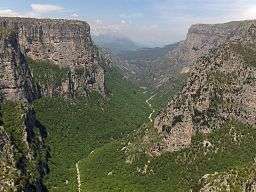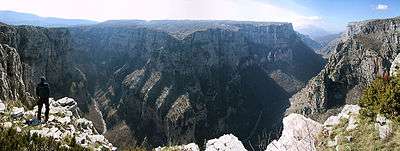Vikos Gorge
Coordinates: 39°58′10″N 20°43′42″E / 39.96944°N 20.72833°E
| Vikos Gorge (Φαρράγγι του Βίκου) | |
 View of Vikos Gorge from Beloi | |
| Country | Greece |
|---|---|
| Region | Epirus |
| District | Ioannina |
| Municipality | Zagori |
The Vikos Gorge (Greek: Φαράγγι του Βίκου) is a gorge in the Pindus Mountains of northern Greece. It lies on the southern slopes of Mount Tymfi, with a length of about 20 km, depth ranging from 450 to 1600 m and a width ranging from 400 m only a few metres at its narrowest part.[1]
Vikos is listed as the deepest gorge in the world by the Guinness Book of Records[2] among others.
Location
The gorge is found in the core zone of the Vikos–Aoös National Park, in the Zagori region. It begins between the villages of Monodendri and Koukouli and ends near the village of Vikos (or Vitsiko).[3] The gorge collects the waters of a number of small rivers and leads them into the Voidomatis River which forms in the gorge. The major part of Voidomatis is only seasonal, and is permanent only at the lowest part of the gorge.[1] Vikos is also a site of major scientific interest, because it is in almost virgin condition, it is a haven for endangered species and contains many and varied ecosystems.
Geomorphology

The Vikos Gorge, with a length of 20 km (12 mi), walls that range from 400 to 1,600 feet (120 to 490 m) deep, and a width from 400 m (1,312 ft) to some metres at its narrowest part is listed by the Guinness Book of Records as the deepest canyon in the world in proportion to its width,[2][4] though some gorge lobbyists contest that claim.[5] The main part of the gorge stretches from the village of Vikos to Monodendri, and attains a depth of about 1,000 m (3,281 ft).[6]
The landscape of the 20 km long gorge, 12 km οf which belongs to the park's core zone,[7] presents a diverse relief and is characterized by abrupt altitudinal changes. Steep slopes and precipitous rocky cliffs dominate in the middle and higher zones respectively. Numerous gullies dissect both sides of the gorge and the movement of water detaching various rocky materials creates extended screes. The gorge, with a northwest-southeast direction,[7] has been carved over millions of years by the Voidomatis River, a tributary of the Aoos. The Voidomatis is mostly seasonal, with year-round flow occurring only in the lower part of the gorge.[8] As the Vikos Gorge is a deep cross section, its slopes expose a series of rocks of different age. The upper layers consist of limestone formations, while the lower ones of grey dolomite.[7] A special feature of the limestone, resulting from its chemical weathering to water, is its caustic nature. Since limestone dissolves as the water percolates through its pores, an extended underground drainage system is developed with caves and channels that enlarge with the time when their roofs collapse producing rocky exposures and perpendicular slopes. For the same reason the water is scarce, and only when an impenetrable stratum is met, the water appears on the surface.[9]
Recreation
There is a natural viewing platform over the deepest part of the gorge at Oxia, a location 3 km by a newly constructed road from the village of Monodendri. Another viewpoint over the gorge is at Beloi, on the eastern side of the gorge, accessible from the village of Vradeto.
A hiking trail descends into the gorge from Monodendri. The trail then leads north through the gorge to the springs of the Voidomatis river, from where paths lead out of the gorge to the village of Papingo on the north side of the gorge, or to the village of Vikos on the south side of the gorge. It is also possible to hike south through the gorge from Monodendri to the 18th century stone bridges near Kipi.
References
- 1 2 Amanatidou, Despoina (2005). "A case study in Vikos-Aoos National Park - Greece" (PDF). University of Freiburg. Retrieved 2009-07-27.
- 1 2 Guinness World Records 2005: Special 50th Anniversary Edition. Guinness World Records. 2004. p. 52. ISBN 978-1-892051-22-6.
- ↑
- "Natura 2000 Data Form. Site code: GR2130009" (PDF). NATURA 2000. 2009. p. 8. Retrieved 2010-07-12.
- ↑ Hatzopoulou Magda. "About Greece-Landscape" (PDF). General Secretariat of Information, Greece. p. 7.
- ↑ Hellander Paul (2008). Greece. Lonely Planet. p. 335. ISBN 978-1-74104-656-4.
- ↑ Amanatidou: p. 17
- 1 2 3 Hanlidou, Kokkini: p. 2
- ↑ Amanatidou: p. 21
- ↑ Amanatidou: pp. 21-22